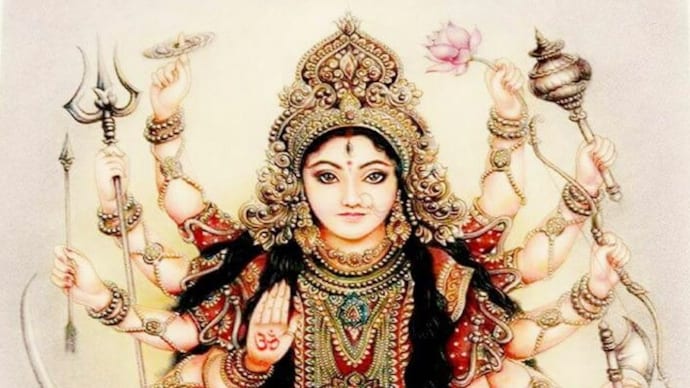#Navratri2017: Decoding Maa Durga's weapons and vehicle
Armed with gifts from the greatest Hindu gods, goddess Durga turned into the ultimate warrior and protector of good.

It doesn't matter if you celebrate her through Navratri or Durga Puja, worship her in the form of Shere Wali Maa or Mahishasurmardini, keep a nine-day-long fast or just a two-day one--but celebrating the magnificence of goddess Durga is just what thise festive season is about.
The ten-armed warrior goddess symbolises everything that the world needs to defeat evil, and devotees appreciate the contribution she has made for our good. But do we know how maa Durga came to be, what her purpose was, and how she won the battle against one of the popular demon-kings from Hindu mythology?

In case you are one of those who don't, here's everything you need to know about the goddess who was created by the gods to get a major victory of good over evil.
Also Read: What is Navratri? What do these nine days of festivities mean?
Mahishasura, the demon-king
Mahishasura was the son of king Ramba, an asura who performed severe penance to get the boon of an invincible son from Lord Agni, the fire god. Ramba's penance was successful, and Agni told him that his son would not be defeated by any man, god or animal. Agni also revealed that the boon would get stronger if Ramba's son got it straight from Lord Brahma, the creator god.
So when Mahishasura performed his share of austerities for Brahma, the god blessed him with what can be considered invincibility--that he cannot be killed by any man, god or animal. Mahishasura then went on to expand his kingdom on earth, and once that was achieved, set out to conquer the heaven, or Indralok, as well.

He was able to quickly rout the devas, who managed to escape and appealed to the tridevas--Brahma, Vishnu, and Shiva. The tridevas realised there was a loophole in Mahishasura's boon, and that he could be defeated by a woman.
That is when the consorts of the three great gods of Hinduism, Devis Saraswati, Lakshmi and Parvati--the three incarnations of Adi Shakti, or the primordial feminine power--conjoined to create the ultimate feminine warrior, Durga.
Also Read: Navratri diet is one of the healthiest, if you do it the right way
The making of Durga
Durga, literally meaning the protector, was born to defeat the conquerer-king, Mahishasura. Once Saraswati, Lakshmi and Parvati combined to incarnate as Durga, the ten-armed super-goddess received gifts and boons from the other gods.

Shiva gave her his trident, Vishnu gave her his Sudarshan Chakra, and Brahma gave her his kamandalam of holy water and wisdom.
Indra gave her his vajra, Varuna gave her his conch, Agni gave her a missile or spear, Vayu gave her a bow and arrows, Vishwakarma gave her his axe and an armour, and the lord of the mountains gave her a lion.
The representations of Durga, whether it's her idols or pictures, carry all these weapons and more. Here is a list of the weapons she carries:
1. Trident or trishul: The three-headed sharp weapon is said to symbolise the three gunas humankind is made of, tamas, rajas and sattva.
2. Discus or Sudarshan Chakra: Vishnu's gift symbolises the centre of creation.
3. Thunderbolt or vajra: Indra's gift symbolises firmness of character, determination, and supreme power.
4. Conch: The conch is the symbol of the primordial sound of creation, Aum.
5. Spear: While a spear symbolises auspiciousness, this gift of Agni also represents pure, fiery power.
6. Sword: Symbolising intellect and wisdom, this weapon is usually carried by people who have a sense of responsibility and the understanding to discern right from worng.
7. Bow and arrows: This combination of potential and kinetic powers symbolises energy.
8. Club or axe: Representations of Durga alternate between these two weapons. Both symbolise the powers of Vishwakarma, and have the power to destroy as well as create.
9. Lotus: The lotus is the symbol of Brahma, and represents wisdom, as well as liberation through knowledge.
10. Snake: While a lot of representations of Durga show one hand empty in blessing, or holding the trishul to kill Mahishasura, the tenth hand is actually supposed to be holding a snake. It symbolises consciousness and the masculine energy of Shiva.

You may not consider the lion, Durga's vehicle, as a weapon. But think about it, isn't a lion a boon to have? The king of the jungle has ferociousness to lead in battle, and the benevolence to forgive past mistakes--a true king.
So it won't be wrong to say that maa Durga carries ten awesome weapons and sits on the king of all animals to go into battle against evil. Isn't that just what makes her the most powerful and popular goddess in India?